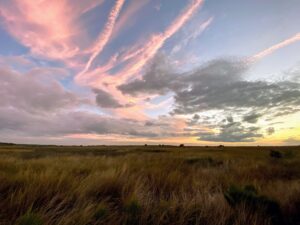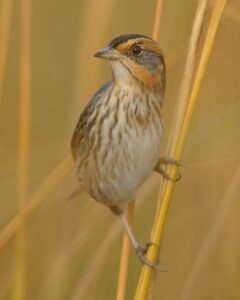
Black Rail Habitat. Photo by Jonathan Fiely
Competitive State Wildlife Grants (C-SWG):
Southeastern JV partners were awarded a $695,000 competitive State Wildlife Grant (C-SWG) in 2021. This grant, led by the Florida Fish and Wildlife Conservation Commission, will restore, enhance or create more than 1,100 acres of Black Rail habitat across four states (VA, NC, SC and FL). Funded projects include the creation of sheet flow wetlands and microtopography to improve Black Rail habitat, manage impoundments to support Black Rails, and implement prescribed burns as a means to manage and create new habitat. All project sites were chosen within habitat buffers identified by the Black Rail working group as having the greatest potential for attracting and supporting Black Rails.
Natural Resource Conservation Services (NRCS) Conservation Effects Assessment Project (CEAP):

Saltmarsh Sparrow. Photo by Mike Kilpatrick
The JV was awarded a second year of funding from NRCS through the CEAP program. The second year of funds will support continuation of critical monitoring and restoration work for Saltmarsh Sparrows, Black Rails and other tidal marsh birds and provide new support for an additional remote sensing project. Funds will support:
- Final year of work to complete the Saltmarsh Sparrow Rapid Demographic Tool validation developed by SHARP. This tool will allow land managers to more quickly evaluate reproductive success to determine whether a given salt marsh is supporting population growth.
- Performance evaluation of more than 25 runnelling and ditch remediation projects in the Northeast to help us determine how well these techniques work to restore marsh resiliency in a variety of marshes.
- Assessment and creation of Black Rail habitat in non-tidal lands. This project will begin to develop and test management techniques that can be applied to inland wetlands in southern Florida and develop management guidance for promising management actions that can be applied throughout the ACVJ Black Rail range.
- New funds to support the use of remote sensing to identify habitat characteristics linked to successful breeding of Saltmarsh Sparrows to help prioritize sites with the greatest potential for restoration.
Superstorm Sandy:
Reallocated funds from Superstorm Sandy were used to support several important salt marsh conservation projects in New Jersey and Delaware. Funds will help:
- Install runnels at Rum Pointe in Sinepuxent Bay to facilitate tidal exchange and vegetation recovery
- Enhance elevation and refurbish breakwaters to improve tidal wetland hydrology at Supawna Meadows NWR
- Use woody, material-based wave attenuation mechanisms to trap sediment, rebuild marsh elevation and improve resiliency of marsh habitats at Bombay Hook NWR
- Design >10 low-tech, low-cost, and low-disturbance salt marsh restoration projects to increase the resiliency of salt marsh habitat in the Mid-Atlantic
Migratory Birds:
Funds from Migratory Birds were used to support the development of much-needed density and occupancy estimates for the Saltmarsh Sparrow from Maine to Virginia. These estimates build upon data collected in 2011/2012 by SHARP and can be used to inform both regional species assessments and local-scale planning efforts in individual marshes. This analysis will specifically deliver:
- A 3x3m raster layer of occupancy probability estimates for the Saltmarsh Sparrow from Maine to Virginia
- A 3X3m raster layer of density estimates for the Saltmarsh Sparrow from Maine to Virginia
- Estimates of both occupancy and density for hybrid Saltmarsh/Nelson’s sparrows within the hybrid zone (southern Maine to northern Massachusetts)
NAWCA & Coastal Grants
Nearly every proposal from ACJV partners that was submitted to the USFWS’s two national wetland grant programs (i.e., NAWCA and NCWCG) in 2021 was funded, closely following last year’s 100% success rate. In the first round of NAWCA Standard ($1M +) grants, nine proposals were funded, providing nearly $11M to conserve 51,723 acres. In the second round, nine of ten proposals were funded, with $15M in grants conserving 72,300 acres. Ten different states were awarded NAWCA grants this year. In the first round, three of the nine awards exceeded $1M ($1.33M, $1.5M, and $2M), which was until recently the typical maximum award. In the second round, five of the nine awards were for $2M! Once again, ACJV projects received a significant proportion of all NAWCA funds for the entire US. Standard grant awards between $1M-2M seem to be the “new norm” now for projects with excellent habitat values! NAWCA Small ($100k) grants submitted in 2021 will be evaluated and awarded in the spring of 2022.

Here are brief summaries of several notable projects that received $2M:
-

Project partners discuss project benefits and celebrate the South FL Wetlands Ecosystem project at East Cape Canal. Photo by Jeff Beal
South Florida Wetland Ecosystems II – Ducks Unlimited was awarded $2M, with $4M in match from Florida Fish & Wildlife Conservation Commission, Audubon Florida, and Wetlands America Trust. This wetland enhancement project in Everglades National Park is likely the largest ever attempted in the ACJV, at 50,000 acres. The project will enhance a mosaic of freshwater habitats that are likely to support ACJV flagship species (breeding and wintering Black Rail, and wintering Saltmarsh Sparrow). National Coastal Wetland Conservation Grant funds were also awarded for this project, for a total of $7.4M in federal grants funds and partner match to this large enhancement project.
- Herring River Restoration and Protection – Ducks Unlimited was awarded $2M with partners such as the Commonwealth of Massachusetts and the National Park Service providing well over $4M in match. This project represents one of the largest salt marsh restoration projects on the East Coast, restoring an entire watershed on Cape Cod that has been largely cut off from tidal flow since the early 1900s. When completed, it will provide >1,000 acres of high quality salt marsh habitat for Saltmarsh Sparrow, Black Duck, and many other high priority species. Remaining project costs are estimated at $15-30M, with the balance expected to be funded by state and federal funds.
- Maine’s Wetlands, from the Headwaters to the Sea – this project, led by Rangeley Lakes Heritage Trust, was awarded $2M, to permanently protect 4,900 acres (1,625 in fee). More than 4,500 acres of the protected land is contiguous, and borders 108k acres of conservation land in Northern Maine. Those tracts include nearly 1,000 acres of wetland and ten miles of undeveloped lake and pond frontage, all of which are prime breeding and migration habitat for American Black Duck. The project also includes several parcels on Maine’s coast, including tidal wetlands in Downeast Maine which provide high-value habitat for wintering Black Ducks, and for other high priority species.
- South Atlantic Basin: Lower Pee Dee to Okefenokee V – the Open Space Institute was awarded $2M to conserve over 5,700 acres on the Santee River system in South Carolina, quickly building a protected and managed landscape similar to the ACE Basin in South Carolina. Matching partners include South Carolina DNR, The Nature Conservancy, Woodruff Foundation, OSI, and the SC Conservation Bank. This South Atlantic Migratory Bird Initiative (SAMBI) project connects a vast landscape of protected properties from coastal GA, north to the ACE Basin, through the Santee River Basin and north into the Cape Fear Region of North Carolina. Three National Coastal Wetland Conservation Grants for $1M each also were awarded to aid in the acquisition of these large forested wetland tracts.
All ten proposals submitted in 2021 for a National Coastal Wetland Conservation Grant were funded, with nearly $9M in grants conserving 59,365 acres in seven states.
Great Lakes Restoration Initiative
One proposal in the ACJV was funded with the Great Lakes Restoration Initiative (GLRI)
JV Habitat Conservation grant program. A project by the Thousand Islands Land Trust in NY’s St. Lawrence River Valley was awarded $300k to permanently protect 735 acres of wetlands and high value upland habitat for priority bird species in BCR 13.
